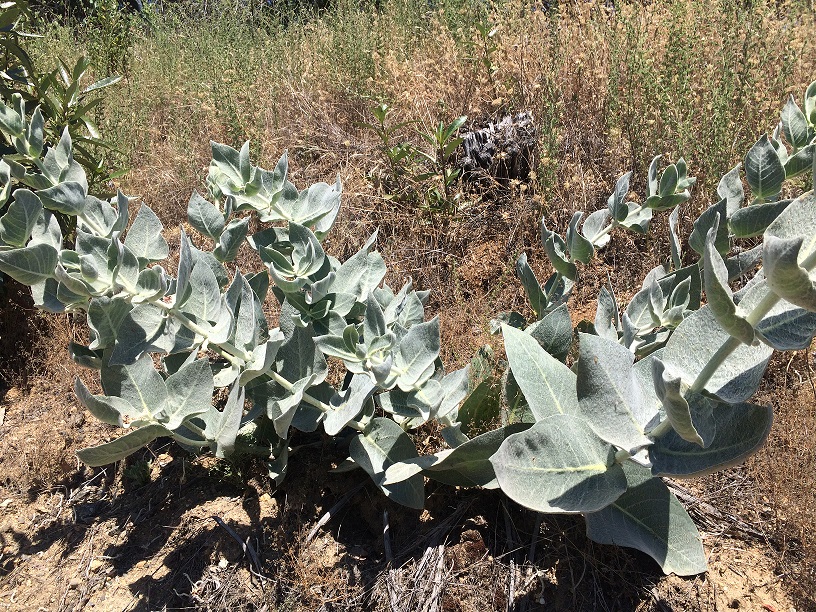

Photo copyright © 2019 Mariposa Native Plants
A native perennial herb, with cream or yellow flower clusters and woolly gray-green, leaves on floppy stems. The plant emerges in the spring and thrives throughout the hot summer, relying upon its deep root system. It produces large seed follicles later in the summer, typically in August or early September, which break open to disperse seeds attached to white, fluffy fibers. A.vestita is winter deciduous. But, as a perennial, it comes back year after year and adds an exotic accent to any California native plant garden. Along with several other species in the Asclepias genus, this plant is a host for the monarch butterfly caterpillar. Woolly Milkweed is endemic to California. It has the largest seed of any of the fifteen milkweeds native to California.
A.vestita is found in the Central Valley, south and east of Stockton and into the adjacent foothills of the Sierra Nevada. It also grows in the Coast Range from Salinas south to Santa Barbara. Lastly, it is found on the lower northern slopes of the San Gabriel and San Bernadino Mountains in southern California. Elevation: sea level to above 8,000 ft. (2500m). Sun: full or partial. Moisture: prefers arid conditions. Temperature: cold tolerant to 25°F (-5°C). Soil: prefers sandy, rocky, and decomposed granite soils; pH 6-8.
Try to get Woolly Milkweed in the ground as soon as is practical; As with other milkweeds A.vestita does not like life in the container. It might be prudent to protect young plants with a gopher cage in the ground and a deer screen above ground. As the plants get older, they develop more of the internal toxic latex sap, and they become unpalatable to herbivores. However, Woolly Milkweed is easy to care for once established. It prefers a site that is well-drained. Roots are sensitive to disturbance; avoid breaking the root ball when planting from the container. Water (1 gallon, 4 liters) once per week until the first winter's soaking rain. Water once per month, same amounts, in the second summer. Thereafter, no supplemental water required. This milkweed can grow to be large plant some 2-3 feet tall and 3-4 feet across, with multiple stems sprouting from the ground. A.vestita propagates through seeds and by way of rhizomes; it can expand beyond its initial space, so this is a consideration in locating it in the garden. Again, the Woolly Milkweed is a host plant for the monarch butterfly caterpillar, so it's possible that the plant can be devoured by caterpillars should the monarchs visit. The good news is that the plants have adapted to this predation, and they bounce back quite quickly.
A.vestita is a host plant for the monarch butterfly's caterpillars. Milkweeds, and A.vestita among them, contain within them an alkaloid that is mildly poisonous and distasteful to birds and other predators. However, the monarch has adapted to this natural fact, and the caterpillars can feed on the milkweed leaves and fine stems, absorb the alklaoid, and become quite unpalatable to predators.
Aphids: Young plants especially are subject to oleander aphids. Brush the aphids off gently by hand, with a soft brush, or with a spray of water from the garden hose. Please do not use pesticides on A.vestita, because these chemicals harm the monarch butterfly caterpillars. California native plants are adapted to withstand the insect pests, and they really don't need chemical help from you to do so. Also, the aphids are a prime food target for the helpful lady beetle insect, so leaving a few of them on the plant confirms an established food and life cycle.
Gophers: Might eat at the roots of A.vestita. It's a good practice to protect young plants with an in-ground gopher cage.
Deer and rabbits: Might browse on young Woolly Milkweeds. Protect young plants with an above-ground screen that is staked to the earth. Once the milkweed is mature (2-3 years), deer and rabbits should not be a problem.
This milkweed is a bit difficult to distinguish from the California Milkweed, Asclepias californica. The differences are that Woolly Milkweed has distinctly more gray-green foliage, its lower leaves have short petioles (leaf stems), grows from singular stems that do not branch off above ground, and its flowers are yellow or cream-colored. In contrast, California Milkweed has greener, less hairy foliage, grows with branching stems, has lower leaves that attach directly to the stem at their base (no significant petioles), and distinctly purple flower clusters.
#1 container (about 1 gallon).
Seeds (24 per package).